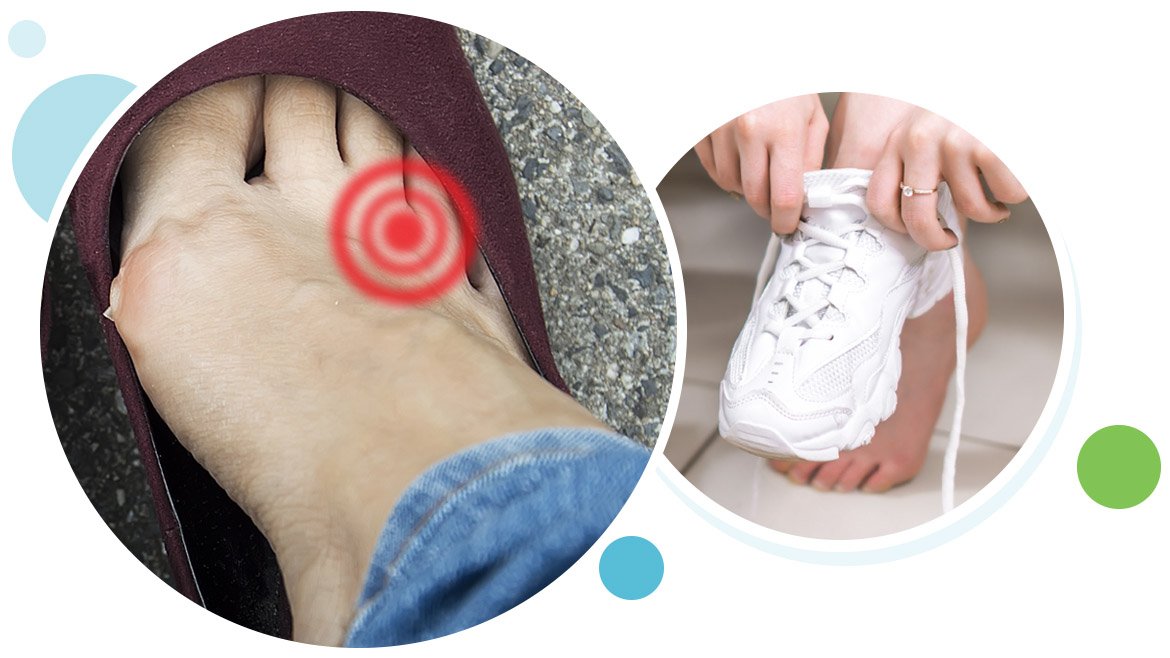Neuromas
Neuromas are a swelling and thickening of the nerve that leads to the toes, which is caused by compression and irritation. When the nerve between the toes enlarges and gets inflamed, it will lead to burning, tingling pain. The most common kind of neuroma is called Morton’s neuroma, which are located at the third interspace of the foot (between long bones of toes 3 and 4). It can be a very painful condition, with symptoms worsening as the nerve enlarges. This progressive disease can cause discomfort along with burning/tingling experienced on the third and fourth digits. Women are much more likely to suffer from the nerve condition because they often wear narrow, high-heeled shoes.
Who Is Affected By Neuromas
Morton’s Neuromas are caused by wearing shoes that are very narrow, or wearing high heels that crowd the toes. Sometimes sports that cause you to suffer from repetitive stress on the forefoot can contribute to the nerve condition. Active women, who enjoy running and young professional women are more likely to suffer from the condition.
Symptoms
As a nerve condition, there are several different symptoms that a neuroma can cause. The symptoms can vary from one person to another and depend on the severity of the neuroma. Here are some of the more common symptoms victims suffer:
- Feeling as if something is stuck in the ball of the foot.
- Feeling like there is something inside the shoe or that a sock is bunched up or has a knot.
- Burning pain in the foot or toes.
- Tingling
- Numbness
- Symptoms worsening or becoming more intense as the nerve enlarges.
- Difficulty walking or putting weight on the affected foot.
Diagnosing Neuromas
Neuromas are not visible on x-rays, so a doctor must make the diagnosis after a physical examination where the nerve is palpated, or a maneuver is done that results in an audible click. In some cases, ultrasound or MRI may be ordered to document size or rule out other etiologies. The doctor will also diagnose based on the symptoms suffered by the patient. Often, the patient will report that the symptoms improve after the foot is massaged or when they wear low-heeled, wider shoes and avoid aggravating activities.
Treatment for Neuromas
The doctor will come up with a treatment plan based on how far the neuroma has progressed. When in its early stages, a metatarsal pad can be used to lessen the pressure on the nerve. Early intervention might involve icing, which will reduce swelling, and over-the-counter inflammatory drugs to decrease inflammation and pain. Sometimes custom or prescription orthotic devices might be used to provide support and reduce compression. Injection therapy may also be utilized depending on the severity of the neuroma.
Some common treatment options include:
- Padding – Padding provides support to the metatarsal arch, decreasing compression while walking and lessening pressure on the nerve.
- Icing – An icepack on the affected area will reduce swelling.
- Orthotic devices – Provide additional support to reduce compression and pressure on the nerve.
- Activity modifications – Avoid activities that put repetitive pressure on the neuroma.
- Shoe modifications – Wear shoes that have a wider toe box. Don’t wear narrow shoes or high heels.
- Medications – Non-steroidal anti-inflammatory drugs can reduce inflammation and help with pain.
- Injection therapy – Injections of local anesthetics or cortisone.
If the condition is severe, surgery might be the best option. The foot surgeon will release or remove the nerve that has been affected through an outpatient surgical procedure. These surgical procedures have a high success rate, relieving the pain.
Recovery from a Neuroma
The length of your recovery period from a neuroma depends on which kind of treatment you have undergone, and whether it was a surgical procedure. Typically patients are back in normal shoe gear after a few weeks from a surgical procedure. Your doctor will make recommendations for long-term care and treatment, so you can keep the symptoms from returning. Your doctor will suggest you wear the appropriate footwear, so you shouldn’t wear shoes with high heels or that are narrow.

